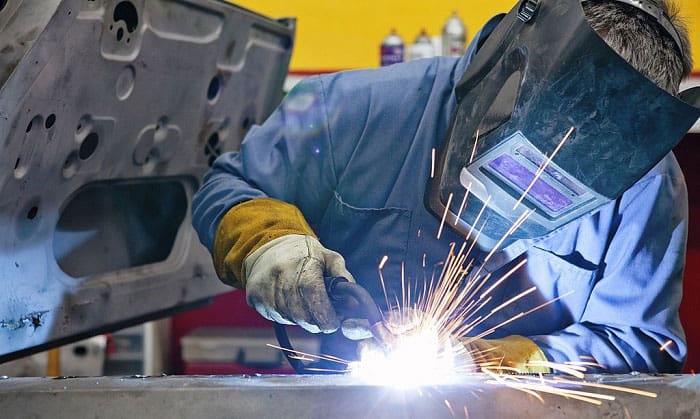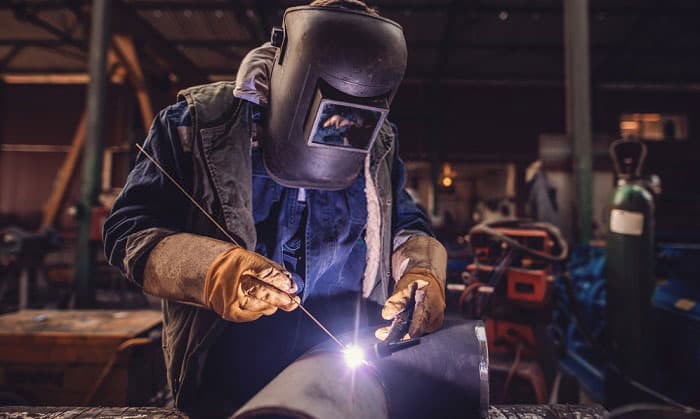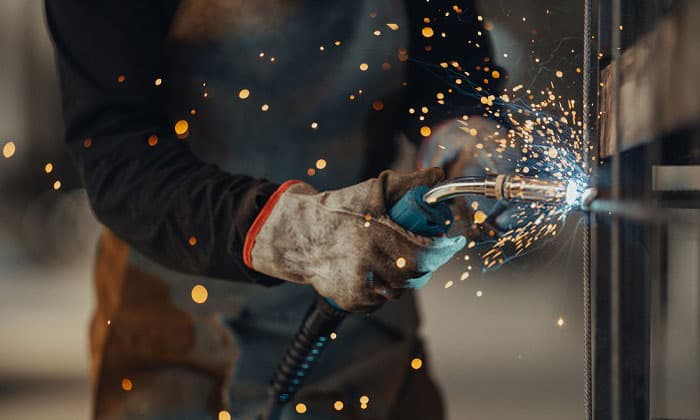Welding is a risky undertaking. It involves working closely with gas flames, extreme heat, electric arc, laser, and ultrasound. Precautions like welding gloves and glasses are required when performing such tasks. But what do welding gloves protect against exactly?
There are four basic types of gloves: TIG, MIG, stick, and cut-resistant. Each has different protective functions and usage. In general, they keep you away from burns, electric shocks, ultraviolet radiation, cuts, and punctures. A good pair of welding gloves provide much more than just standard protection. The materials must enhance grip and comfort while allowing a high level of dexterity.
Dive in for further details!
Table of Contents
What Is a Welding Glove
Welders’ gloves are designed to protect your hands from heat, flames, and electric shock. ANSI (American National Standards Institute) has published the standard Z49.1, which announces that protective gloves are mandatory for all cutters and welders. The required gloves depend on each specific welding technique.
The most common mishaps welders experience include electric shocks, skin burns, and injuries. Worse, the hand can coincidentally be crushed or cut by sharp objects. Dealing with hot metal, debris, and sparks should never be taken carelessly. The general protective features of PPE gloves include:
- Electrical hazards protection
- Heat insulation
- Water resistance
- Breathability, comfort, and durability
- Puncture and cut resistance
- High-quality materials
Please wear safety gloves at all times during welding operations. Also, you should regularly check for cuts, holes, or abrasions. Damaged welding gloves won’t protect your hands.
Different Types of Welding Gloves and Their Functions
Welding gloves in the market are mostly made from full-grain leather obtained from animals, such as cows, goats, pigs, and deer. Their applications depend on the materials.
1. TIG welding gloves
A TIG (tungsten-electrode inert gas) welding procedure uses a non-consumable tungsten electrode and consumable filler material to generate high heat that melts and joins the metals. This method is more time-consuming and costly than others. However, TIG allows welders to produce a narrow and focused arc on extremely thin materials.
The type of gloves used in such procedures needs to be flexible and heat-insulated. The gloves must offer enough dexterity for welders to easily control and concentrate the torch. Besides, gauntlet welding gloves are recommended to protect the wrists.
Sometimes, they come with palm paddings to diminish the TIG torch vibration for maximal precision. To be marked as qualified TIG welding gloves, the products must be tested to meet the ANSI heat protection level 2 and puncture resistance level 3.
High-quality TIG welding gloves can be made from lightweight top-grain leather or goatskin. Top-grain leather comes from the outer layer of an animal’s skin. It is soft, stretchy, yet thick enough to insulate the heat. If TIG is your regular working procedure, watch this video for specific product recommendations.
2. MIG welding gloves
MIG welding is pretty similar to TIG. The main difference is that it uses a continuous and consumable wire electrode instead of a tungsten one. This method is faster and more cost-effective, but it cannot be used for meticulous welding. It is usually for larger projects with thick metals that require continuous runs. Though both TIG and MIG are lower heat welding procedures, MIG generates slightly more heat than TIG.
Besides heat, performing a MIG (metal inert gas), also known as GMAW (gas metal arc welding), puts the welders at risk of arc radiation, fumes, and electrical hazards. MIG gloves are made from high-grade leather such as cowhide. Since the gloves are mostly worn over a prolonged time, many brands add Kevlar threading, lined interior, and leather stress points to provide more comfort and durability.
3. Stick welding gloves
Stick welding or manual arc welding generates tremendously high heat, far more than TIG. Thus, welders should be equipped for thermal contact. The temperature can range from 5400°F to 36,000°F. In addition to being heat-resistant, the materials do not harden when regularly exposed to extreme heat. An amazing feature of such gloves is the aluminum foil backing. Instead of absorbing, aluminum reflects radiant heat.
4. Cut-resistant gloves
Lastly, there are welding gloves made mainly to resist cuts and punctures. They are for when you have to work with sharp objects and blades. These are often long welding gloves that feature heavy-duty Kevlar, cotton, or aluminum foil knitted lining. Some brands coat the gloves with nitrile for maximum protection.
Choosing the Right Welding Gloves
If you perform different welding methods on the job site, you should have more than one pair of protective gloves. When purchasing and choosing welding gloves, take note of these four factors.
- Heat resistance: This is unquestionably the most important safety function of welding gloves. When you’re not sure what type to get, consider the amount of emitted heat involved in your regular procedures and select the gloves accordingly. For a welding torch around 90 Amps, Kevlar liners should be good enough. A higher level of heat from 125 Amps to 250 Amps requires cotton or foam insulation. If you’re dealing with over 500 Amps stick welding, aluminum safety backing is crucial.
- ANSI-certified: Not all products advertised as safety welding gloves are ANSI-certified so you must always check their testing and certifications. Make sure your pair can handle the welding hazards safely.
- Fitting: Never assume you know your glove size. The sizes can vary by brand and model. Rather, measure your dominant hand carefully following the guide on the brand’s website. You will need a measuring tape to measure your dominant hand widthwise and lengthwise. Then, calculate your size. A tip is to compare the measurements with your favorite pair of gloves.
- Comfort: If you buy gloves from a store, put them on and try to pick up something small like a coin. The materials should be breathable and moisture-wicking. Also, since leather naturally dries out when exposed to heat for a prolonged period, check that there are paddings on the index fingers, thumbs, palms, and the hand’s metacarpus. To prevent the leather from hardening, you can use anti-spatter sprays.
Conclusion
We hope you’ve gathered enough useful information to understand what do welding gloves protect against and their functions. Besides gloves, remember to put on other safety gear like goggles and face masks when performing hazardous welding tasks. Always put your safety first.
Before you leave, let us know in the comment section should you have any further questions. We are more than glad to assist. See you then!

Veronica is our content editor. She is a talent in delivery. Her main work is editing and writing articles that are both informative and simple to follow. She is in charge of synthesizing our understanding of what personal protection equipment (PPE) is needed in each job, how to best apply it, and how to visualize that equipment.




